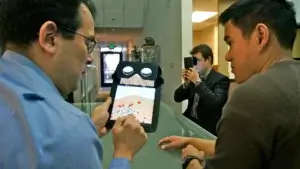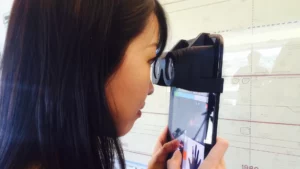Background
Immersive technology hardware tends to be expensive to purchase, costly to maintain and cumbersome to use. To address this limitation, ICT has been a pioneer in low cost VR hardware R&D since 2010.
Initial experiments included working with tablets to achieve a larger Field of View (FOV), but researchers quickly discovered that the tablet could offer a novel hybrid platform consisting of 2D touch and 3D visualizations in one platform, providing immersive experiences with the lowest barrier of entry.
This patented “casual immersive” platform has been employed on DARPA’s XDATA big data visualization project, as well as ONR’s Enhanced Environment for Communication and Collaboration (E2C2 or Blue Shark).
Consisting of a hybrid 2D touch-screen, with a 3D-based media interface, its hardware can be reproduced inexpensively and easily using a 3D printer. The hardware components of INVRSE include a simple lens assembly which slides onto the top portion of a tablet screen.
Objectives
ICT’s INVRSE delivers a hybrid and holistic media ecosystem, combining traditional 2D formats like text, photos and videos with immersive mediums like VR and AR. INVRSE allows users to intuitively and casually dip in and out of various formats without having to switch apps, platforms, or devices. Content for INVRSE runs on widely used mobile-based technology and hardware. Media can be streamed from either a WiFi or a cellular network, or locally on devices in areas of limited to no connectivity.
INVRSE also has the capacity to go from being an individual experience to a fully social one. Creators can network devices together and designate a leader to guide a team of users through an immersive experience. This is particularly impactful in the sectors which have training and education at their cores.
Results
INVRSE has been used to provide research and development solutions for the US Navy exploring the future of communication and collaboration and for DARPA investigating body based interactions for big data visualization and analysis.
Next Steps
The future capabilities of an INVRSE solution seeks to include an easy-to-use authoring tool complete with templates and guidelines to help add, edit, and share hybrid – immersive media. The MxR Lab is currently seeking partners to help transition the INVRSE platform to the world at large.
For more information, please contact David Nelson, senior producer, MXR Lab at: dnelson@ict.usc.edu.


